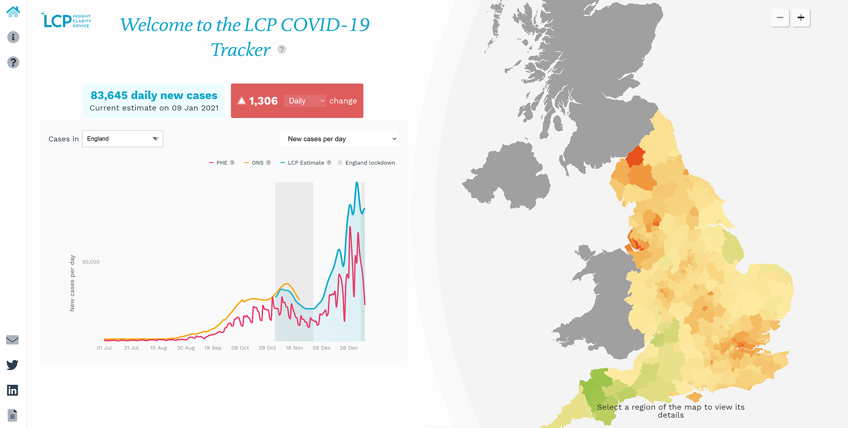The LCP
Covid-19 Tracker – timely estimates to inform targeted action
Our viewpoint
12 January 2021
The LCP Covid-19 Tracker has been developed to help improve and better tailor measures to break the chain of transmission of the virus, slow or prevent exponential growth in cases, and reduce the impacts of the pandemic on lives lost, the health system and wider society.

Now that testing capacity has reached around half a million tests each day, the data has become much more granular. This allows approaches to control the virus to move from ‘one size fits all’ to more tailored and local measures, such as the tiered system introduced in Autumn 2020.
However, current efforts are hampered by test data that do not capture positive but asymptomatic individuals, and which lag behind the real-time situation by days or weeks. Using two sets of official test data and established actuarial methods to integrate and analyse both data sets, the LCP Covid-19 Tracker provides an up-to-date estimate of the true prevalence of the virus nationally and locally. This is crucial information for those seeking to establish timely and proportionate interventions to control the virus in different parts of the country as we move into the next phase of the pandemic.
Data sources for the LCP Covid-19 Tracker
There are currently two main sources of official Covid-19 case estimates, from Public Health England (PHE) and the Office for National Statistics (ONS).
The PHE Covid-19 testing data is released daily on the UK Government dashboard, and reflects the number of positive results in those who have requested a test because they have symptoms. This data source will always be an underestimate of the true number of new cases because as many as one in three people with Covid-19 have no symptoms. There is also a time lag between the date of a Covid-19 test being taken by an individual (the test date) and the date that the result of that test is recorded (date reported), and the case numbers we see each day are usually from test results covering a number of previous days. This means the daily figures are often incomplete and will be revised upwards over time.
The ONS Covid-19 infection survey tests a random sample of the population each week to estimate the ‘true’ prevalence of infection in the community at any one time. This data is usually published weekly, with a time lag of between 6 and 12 days.
The LCP Covid-19 Tracker aims to be as close to real-time as the PHE daily data, but as comprehensive as the ONS approach. Combining both datasets and using established actuarial methods provides a more rounded estimate of current new infection rates.
The LCP Covid-19 Tracker enables new daily cases and current prevalence for England, the regions and local authorities to be estimated, taking account of the observed pattern of past time-lags between the test date and the reporting date, and also observed differences between past PHE testing data and ONS surveillance data. The infection rates are then standardised to regional ONS populations for those aged 2 and over to estimate the total number of new daily cases per 100,000 people. A similar method is used to estimate current case prevalence rates. You can read the full methods behind our estimates here.
Local data to inform local decisions
The importance of data like that provided by the LCP Covid-19 Tracker for developing both national and local measures to control the virus can be seen when we look more closely at what happened last November.
The November lockdown worked but cases soon bounced back. Using the LCP Covid-19 Tracker, we estimated that the number of daily new cases declined substantially during the national four-week lockdown period from November to early December, dropping from approximately 29,600 cases per day on 4 November to approximately 20,500 daily cases by 2 December, a fall of around 31%.
However, this decline soon appeared to plateau, with large increases through December leading to a quadrupling of daily case numbers in just one month. We estimated eight consecutive days of new daily cases exceeding 80,000 from 28 December to 4 January, with a high point of nearly 100,000 new cases on a single day. The London region contributed around a quarter of these new cases.
When we analysed the growth in daily Covid-19 cases after the November lockdown in the run up to Christmas, there were some stark findings:
- Those areas that were in Tier 2 but were put into Tier 4 on 19 December following substantial increases in case numbers, largely attributed to the so-called ‘Kent’ strain of Covid-19, saw an average daily case growth rate of 7.9% in the two weeks from 2 to 15 December.
- This compared with growth rates of 5.5% in other Tier 2 areas without large proportions of the new strain.
- However, this was still many times higher than the 1.4% daily case growth rate seen in areas in Tier 3, suggesting that, while the increased infectivity of the new strain played a major role, Tier 3 restrictions seemed to be much more effective at controlling virus spread than those of Tier 2.
We will continue to track the variations in new daily cases and prevalence of Covid-19 across England, and monitor how they are impacted by the roll out of the vaccine. These estimates will provide essential information for national and local decision-makers developing the measures required to safely exit lockdown and move back to a tier-based system.

